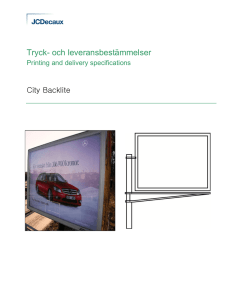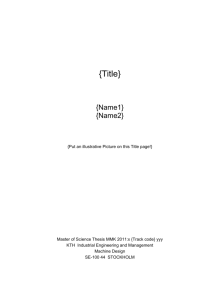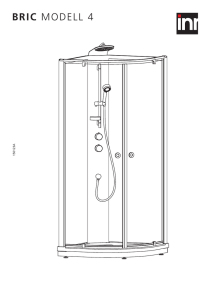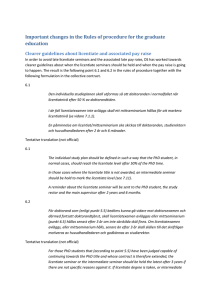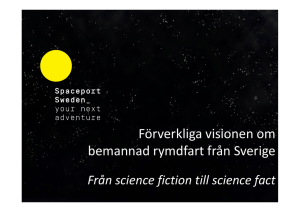Sample manuscript - Greenwich University
advertisement
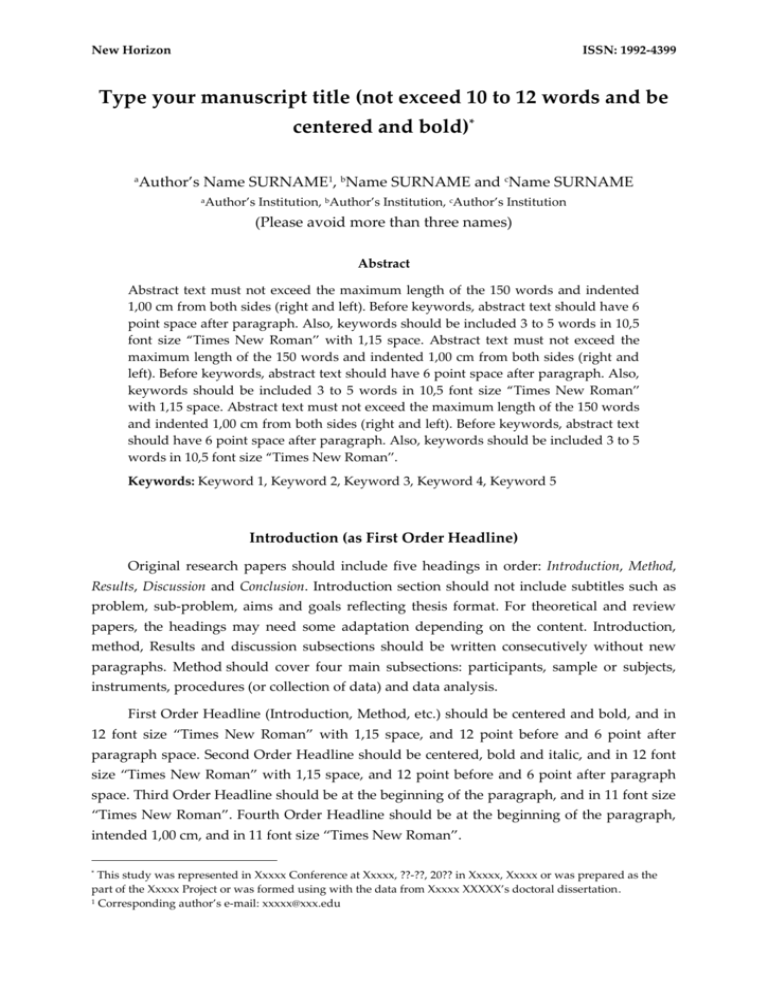
New Horizon ISSN: 1992-4399 Type your manuscript title (not exceed 10 to 12 words and be centered and bold)* Author’s Name SURNAME1, bName SURNAME and cName SURNAME a Author’s Institution, bAuthor’s Institution, cAuthor’s Institution a (Please avoid more than three names) Abstract Abstract text must not exceed the maximum length of the 150 words and indented 1,00 cm from both sides (right and left). Before keywords, abstract text should have 6 point space after paragraph. Also, keywords should be included 3 to 5 words in 10,5 font size “Times New Roman” with 1,15 space. Abstract text must not exceed the maximum length of the 150 words and indented 1,00 cm from both sides (right and left). Before keywords, abstract text should have 6 point space after paragraph. Also, keywords should be included 3 to 5 words in 10,5 font size “Times New Roman” with 1,15 space. Abstract text must not exceed the maximum length of the 150 words and indented 1,00 cm from both sides (right and left). Before keywords, abstract text should have 6 point space after paragraph. Also, keywords should be included 3 to 5 words in 10,5 font size “Times New Roman”. Keywords: Keyword 1, Keyword 2, Keyword 3, Keyword 4, Keyword 5 Introduction (as First Order Headline) Original research papers should include five headings in order: Introduction, Method, Results, Discussion and Conclusion. Introduction section should not include subtitles such as problem, sub-problem, aims and goals reflecting thesis format. For theoretical and review papers, the headings may need some adaptation depending on the content. Introduction, method, Results and discussion subsections should be written consecutively without new paragraphs. Method should cover four main subsections: participants, sample or subjects, instruments, procedures (or collection of data) and data analysis. First Order Headline (Introduction, Method, etc.) should be centered and bold, and in 12 font size “Times New Roman” with 1,15 space, and 12 point before and 6 point after paragraph space. Second Order Headline should be centered, bold and italic, and in 12 font size “Times New Roman” with 1,15 space, and 12 point before and 6 point after paragraph space. Third Order Headline should be at the beginning of the paragraph, and in 11 font size “Times New Roman”. Fourth Order Headline should be at the beginning of the paragraph, intended 1,00 cm, and in 11 font size “Times New Roman”. This study was represented in Xxxxx Conference at Xxxxx, ??-??, 20?? in Xxxxx, Xxxxx or was prepared as the part of the Xxxxx Project or was formed using with the data from Xxxxx XXXXX’s doctoral dissertation. 1 Corresponding author’s e-mail: xxxxx@xxx.edu * Title of the study Literature Review (as Second Order Headline) Original research papers should include five headings in order: Introduction, Method, Results, Discussion and Conclusion. Introduction section should not include subtitles such as problem, sub-problem, aims and goals reflecting thesis format. For theoretical and review papers, the headings may need some adaptation depending on the content. Introduction, method, Results and discussion subsections should be written consecutively without new paragraphs. Method should cover four main subsections: participants, sample or subjects, instruments, procedures (or collection of data) and data analysis. First Order Headline (Introduction, Method, etc.) should be centered and bold, and in 12 font size “Times New Roman” with 1,15 space, and 12 point before and 6 point after paragraph space. Second Order Headline should be centered, bold and italic, and in 12 font size “Times New Roman” with 1,15 space, and 12 point before and 6 point after paragraph space. Third Order Headline should be at the beginning of the paragraph, and in 11 font size “Times New Roman”. Fourth Order Headline should be at the beginning of the paragraph, intended 1,00 cm, and in 11 font size “Times New Roman”. Method (as First Order Headline) Original research papers should include five headings in order: Introduction, Method, Results, Discussion and Conclusion. Introduction section should not include subtitles such as problem, sub-problem, aims and goals reflecting thesis format. For theoretical and review papers, the headings may need some adaptation depending on the content. Introduction, method, Results and discussion subsections should be written consecutively without new paragraphs. Method should cover four main subsections: participants, sample or subjects, instruments, procedures (or collection of data) and data analysis. Participants (as Third Order Headline): First Order Headline (Introduction, Method, etc.) should be centered and bold, and in 12 font size “Times New Roman” with 1,15 space, and 12 point before and 6 point after paragraph space. Second Order Headline should be centered, bold and italic, and in 12 font size “Times New Roman” with 1,15 space, and 12 point before and 6 point after paragraph space. Third Order Headline should be at the beginning of the paragraph, and in 11 font size “Times New Roman”. Fourth Order Headline should be at the beginning of the paragraph, intended 1,00 cm, and in 11 font size “Times New Roman”. Instruments (as Third Order Headline): Original research papers should include five headings in order: Introduction, Method, Results, Discussion and Conclusion. Introduction section should not include subtitles such as problem, sub-problem, aims and goals reflecting thesis format. For theoretical and review papers, the headings may need some adaptation depending on the content. Introduction, method, Results and discussion subsections should be written consecutively without new paragraphs. Method should cover four main 2 Title of the study subsections: participants, sample or subjects, instruments, procedures (or collection of data) and data analysis. Scale A (as Fourth Order Headline): First Order Headline (Introduction, Method, etc.) should be centered and bold, and in 12 font size “Times New Roman” with 1,15 space, and 12 point before and 6 point after paragraph space. Second Order Headline should be centered, bold and italic, and in 12 font size “Times New Roman” with 1,15 space, and 12 point before and 6 point after paragraph space. Third Order Headline should be at the beginning of the paragraph, and in 11 font size “Times New Roman”. Fourth Order Headline should be at the beginning of the paragraph, intended 1,00 cm, and in 11 font size “Times New Roman”. Results (as First Order Headline) Original research papers should include five headings in order: Introduction, Method, Results, Discussion and Conclusion. Introduction section should not include subtitles such as problem, sub-problem, aims and goals reflecting thesis format. For theoretical and review papers, the headings may need some adaptation depending on the content. Introduction, method, Results and discussion subsections should be written consecutively without new paragraphs. Method should cover four main subsections: participants, sample or subjects, instruments, procedures (or collection of data) and data analysis. Table 1. Frequency and percentage distribution of pre-service teachers in the sample Specialties Age Gender 1 2 3 4 18-19 20-21 22-23 +24 n 74 197 146 35 452 % 16,37 43,58 32,30 7,75 100 Male Female 165 287 n % Type of the 5 Total 452 36,50 63,50 Normal Anatolian An.Tec. Super Vocat. 100 Graduated n 128 165 46 65 48 452 High Sch. % 28,32 36,50 10,18 14,38 10,62 100 1. Grd. 2. Grd. 3. Grd. 4. Grd. n 110 116 120 106 452 % 24,34 25,66 26,55 23,45 100 Grade First Order Headline (Introduction, Method, etc.) should be centered and bold, and in 12 font size “Times New Roman” with 1,15 space, and 12 point before and 6 point after paragraph space. Second Order Headline should be centered, bold and italic, and in 12 font size “Times New Roman” with 1,15 space, and 12 point before and 6 point after paragraph space. Third Order Headline should be at the beginning of the paragraph, and in 11 font size 3 Title of the study “Times New Roman”. Fourth Order Headline should be at the beginning of the paragraph, intended 1,00 cm, and in 11 font size “Times New Roman”. Figure 1. World map Original research papers should include five headings in order: Introduction, Method, Results, Discussion and Conclusion. Introduction section should not include subtitles such as problem, sub-problem, aims and goals reflecting thesis format. For theoretical and review papers, the headings may need some adaptation depending on the content. Introduction, method, Results and discussion subsections should be written consecutively without new paragraphs. Method should cover four main subsections: participants, sample or subjects, instruments, procedures (or collection of data) and data analysis. First Order Headline (Introduction, Method, etc.) should be centered and bold, and in 12 font size “Times New Roman” with 1,15 space, and 12 point before and 6 point after paragraph space. Second Order Headline should be centered, bold and italic, and in 12 font size “Times New Roman” with 1,15 space, and 12 point before and 6 point after paragraph space. Third Order Headline should be at the beginning of the paragraph, and in 11 font size “Times New Roman”. Fourth Order Headline should be at the beginning of the paragraph, intended 1,00 cm, and in 11 font size “Times New Roman”. 4 Title of the study Graph 1. Internet usage rate according to gender Original research papers should include five headings in order: Introduction, Method, Results, Discussion and Conclusion. Introduction section should not include subtitles such as problem, sub-problem, aims and goals reflecting thesis format. For theoretical and review papers, the headings may need some adaptation depending on the content. Introduction, method, Results and discussion subsections should be written consecutively without new paragraphs. Method should cover four main subsections: participants, sample or subjects, instruments, procedures (or collection of data) and data analysis. Discussion and Conclusion (as First Order Headline) Original research papers should include five headings in order: Introduction, Method, Results, Discussion and Conclusion. Introduction section should not include subtitles such as problem, sub-problem, aims and goals reflecting thesis format. For theoretical and review papers, the headings may need some adaptation depending on the content. Introduction, method, Results and discussion subsections should be written consecutively without new paragraphs. Method should cover four main subsections: participants, sample or subjects, instruments, procedures (or collection of data) and data analysis. First Order Headline (Introduction, Method, etc.) should be centered and bold, and in 12 font size “Times New Roman” with 1,15 space, and 12 point before and 6 point after paragraph space. Second Order Headline should be centered, bold and italic, and in 12 font size “Times New Roman” with 1,15 space, and 12 point before and 6 point after paragraph space. Third Order Headline should be at the beginning of the paragraph, and in 11 font size “Times New Roman”. Fourth Order Headline should be at the beginning of the paragraph, intended 1,00 cm, and in 11 font size “Times New Roman”. References should follow the latest APA style as described in the Publication Manual of the American Psychological Association. Title References as a first order headline should be written centered, bold, and in 12 font size “Times New Roman” with 1,15 space, and 12 5 Title of the study point before and 6 point after paragraph space. On the other hand, each references in the list should be written in 10,5 font size “Times New Roman” with 1,15 space and hanged in 1,00 cm. Citation in text Single author: (Arslan, 2005) – (Arslan, 2005: 27) – As Arslan (2005) – As Arslan (2005: 27) – According to Arslan (2005) – According to Arslan (2005: 27) Two author: (Arslan and Kocayörük, 2006) – (Arslan and Kocayörük, 2006: 72) – As Arslan and Kocayörük (2006) – As Arslan and Kocayörük (2006: 72) – According to Arslan and Kocayörük (2006) – According to Arslan and Kocayörük (2006: 72) Three author: (Arslan, Kocayörük and İçbay, 2007) – (Arslan, Kocayörük and İçbay, 2007: 52) – As Arslan, Kocayörük and İçbay (2007) – As Arslan, Kocayörük and İçbay (2007: 52) – According to Arslan, Kocayörük and İçbay (2007) – According to Arslan, Kocayörük and İçbay (2007: 52) Four or more author: (Arslan et al., 2008) – (Arslan et al., 2008: 25) – As Arslan et al. (2008) – As Arslan et al. (2008: 25) – According to Arslan et al. (2008) – According to Arslan et al. (2008: 25) Consecutive references: (Arslan, 2005; Arslan and Kocayörük, 2006; Arslan, Kocayörük and İçbay, 2007; Arslan et al., 2008) Citating a citation: (Arslan, 2005 as cited in Kocayörük, 2006). References should follow “Conclusion” section. All Reference List entries should be in alphabetical order by the last name of the first author of each source. Do not number entries. References Journal Articles Single Author Aboderin, I. R. (2004). Modernisation and ageing theory revisited: Current explanations of recent developing world and historical Western shifts in material family support for older people. Ageing & Society, 24(2), 29-50. Two authors Baltes, P. & Staudinger, U. (1993). The Search for a psychology of wisdom. Current Directions in Psychological Science. 2(3), 74-86. Three authors Bengston, V. L., Burgess, E. O. & Parrott, M. T. (1997). Theory, explanation and a third generation of theoretical development in social gerontology. Journal of Gerontology: Social Sciences, 52(2), 72-88. Four or more authors Wolchik, S. A. et al. (2000). An experimental evaluation of theory-based mother and mother-child programs for children of divorce. Journal of Consulting and Clinical Psychology , 68(7), 843856. Books 6 Title of the study Single Author Bee, H. (1994). Lifespan development. New York: Harper Collins. Two authors Danigelis, N. L. & Fengler, A. P. (1991). No place like home: Intergenerational homesharing through social exchange. New York: Columbia University Press. Edited Book Balota, D. A., Dolan, P. O. & Duchek, J. M. (2000). Memory changes in healthy young and older adults (pp. 395-410) in E. Tulving & F. I. M. Craik (Eds.) Handbook of Memory. Oxford: Oxford University Press. Translated Books Hellman, H. (2001). Büyük çekişmeler: Bilim tarihinden seçilmiş on tartışma. F. Baytok. (Trans.) Ankara: Tübitak Yayınları Proceedings of Meetings and Symposia Unpublished contribution to a symposium/paper presented at a meeting Arslan, H., Kocayörük, E. & İçbay, M. A. (2010, June). The meaning of learning strategies of preservice teachers. Represented in XIV. International Congress on Educational Science, University of Duisburg, Duisburg, Germany. Published proceedings, published contribution to a symposium, article or chapter in an edited book Arslan, A., Kocayörük, E. and İçbay, M. A. (2011). Examining of relationship between organizational citizenship and leadership style of principles in primary schools (pp. 622636) H. Kıran (Ed.) in IV. National Conference on Educational Science Proceeding Book. Pamukkale University, Denizli, Turkey. Dissertations and theses Dursun, E. (2007). An Investigation into research of gender differences in foreign language success at university level prep classes. Unpublished MA thesis. Çanakkale Onsekiz Mart University, Çanakkale, Turkey. Government report European Association of Education (2000). Teacher education in Europe: 2000-2010. Brussels: EAE Publishing. [Online]: http://www.eae.org (March 13, 2011) Newspaper Articles Godin, A. S. (January 09, 2007). Teacher education system. Washington Post. pp. 8. [Online]: http://www.washingtonpost.com (February 21, 2009) Electronic Resources Article in an Internet-only journal Fredrickson, B. L. (2000, March 7). Cultivating positive emotions to optimize health and wellbeing. Prevention & Treatment, 3, Article 1a. [Online]: http://www.journals.apa.org/prevention/volume3/pre0030001a.html (Retrieved in November 03, 2012) Electronic Journal Article from a Database Saracho, O, N. (1999). A Factor analysis of preschool children's play strategies and cognitive style. Educational Psychology, 19(2), 165-178. [Online]: http://www.ebsco.com EBSCO Database (Retrieved in July 21, 2009) Electronic Book 7 Title of the study Seligman, M. E. (2002). Positive psychology, positive prevention, and positive therapy (pp. 3-9) in C.R. Snyder & S. J. Lopez (Eds.) Handbook of Positive Psychology. New York: Oxford University Press. [Online]. http://www.site.ebrary.com/lib/pamukkale (Retrieved in April 18, 2007) 8
